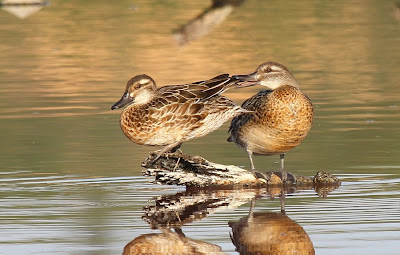The best time to be there is just as the sun pokes its face through the early morning murk, which seems to also be an alarm call for the birds to wake up!

Suddenly the place transforms from a serene backwater to a hive of activity, buzzing with birds!

The Black-capped Kingfisher was in its usual corner - timid of photographers but bold in chasing off other occupiers of its favourite perches!

Bee-eaters and mynas scattered before it as it made its regular circuit of dead trees, though it did veer off at the last moment when faced with a pond-heron perched on its branch.

Black-winged Stilts breed here, but their numbers are augmented at this time of year by migrants, some of which show variable blackish head and neck markings.


Whiskered Terns suddenly appeared in droves as the sun came up.

I would have driven past the Garganeys if BK Lim (aka the Point and Shoot King!) had not pointed them out to me, much nearer than I'd seen them before, perched together on a log. Hubby was having a snooze while the missus looked a little more alert.

She decided it was time to do her make-up while he slept on (the brown forewing is how we know she's a she).

All this activity proved too much of a disturbance to his slumbers, so he told her to push off!

Ah - that's better - a guy needs a bit of elbow room to stretch - check out those beautiful lavender grey epaulettes!

Now that's just showing off!

Heading for breakfast, with the female (who has a much brighter face pattern) leading the way.

A nearby Little Grebe caught my attention. A recent paper on grebe taxonomy in South-east Asia (Mlíkovský 2010. Systematic notes on Asian birds: 74. A preliminary review of the grebes, family Podicipedidae. BOC Occas Publs 5: 125-131.) proposes splitting the Little Grebes in South-east Asia from those in parts of Indonesia on the basis of bill size and belly colour (the newly proposed Tachybaptus tricolor having a dark belly; T. ruficollis having a white or whitish belly). So I was keen to see if this bird would show me its belly!

It duly obliged, revealing a gleaming white belly, but when it did so, I got a surprise - the bird was moulting feathers left and right, and had practically no flight feathers!

You can see that all the primaries and some secondaries are growing out at the same time. I knew that many duck species undergo a simultaneous moult of flight feathers, when they become briefly flightless, but I hadn't realized that this also happens with Little Grebes. A quick internet search on getting home revealed this to be the case (e.g.here).

There goes another one! This bird seemed really keen to get all of those old feathers out as soon as possible!

After all that action the bird decided to 'put its feet up', revealing the rather finger-like toes (which even have nails rather than claws).


A Wood Sandpiper provided a brief distraction, and enabled me to improve on the landing shot I took the other day.

However, all thoughts of Wood Sandpipers were pushed aside by the appearance of a snipe by the roadside. Long-term readers of this blog will know that these interest me a great deal, and the chance of a close encounter with one was not to be missed!

This turned out to be an EXTREMELY close encounter, with the bird allowing me to park my car less than 3 metres away, forcing me to zoom out to 250mm to get the bird in frame! This is a Common Snipe (I've covered how to tell these from Swinhoe's/Pintail Snipes in other posts).

The interesting thing about this bird was that the 'macro range' enabled me to take a good look at the coverts. There were clearly two age classes visible. The lesser coverts (circled in white and labelled 1) were much more heavily worn than the medians (pink and numbered 2). The lesser coverts (or most of them) show an unbroken buff fringe and are juvenile feathers. The median coverts show a clear dark wedge at the tip, separating the buff into two spots either side of the central shaft. These are adult-type feathers. So this bird is a '1st winter' (hatched last year).

This was the nearest I got to a clear shot - always a challenge with snipes!

Last bird of the day was this pale morph Changeable Hawk-eagle. By now the light was against me, but I don't have many decent shots of this species, so thought I would try my luck.
6 comments:
This place has always something up its sleeve :)
Good hunting.Hope to be there during CNY holidays.......mikebirder
Great shots - especially the Garganeys!
Love the kingfisher photos and description of behavior! The explanations and views of the grebe and the snipe are really helpful for me too. Very interesting pose of the male garganey in the one shot - it doesn't quite look like a stretch (but I guess its not preparation for a dive!)
Glad to see you're getting out - thanks for taking the time to share.
Interestingly I looked at grebe specimens at Tring recently - there are birds from the Thames with black bellies! Bit dodgy if you ask me...
James
Seems to be variable on European birds: http://www.ibercajalav.net/img/05_LittleGrebeTruficollis.pdf
Post a Comment